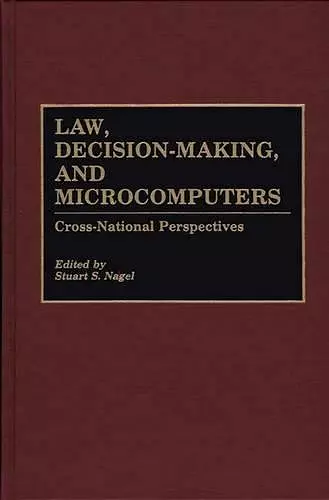Law, Decision-Making, and Microcomputers
Cross-National Perspectives
Format:Hardback
Publisher:Bloomsbury Publishing PLC
Published:28th Feb '91
Currently unavailable, and unfortunately no date known when it will be back

This volume examines the role that microcomputers and decision-aiding software can play in the various aspects of the legal profession. The contributors focus on the normative and predictive questions that are faced by practicing lawyers, legal policy-makers, and legal scholars, and analyze the possibilities that different types of software can offer in answering these questions.
A survey of microcomputers and decision-aiding software in law practices and the legal process. The contributors deal with the practising lawyer, the legal policy maker and the legal scholar and cover the normative and predictive questions that microcomputers and software can help to answer.
The rise of microcomputers and the power that they've brought have revolutionized nearly every professional discipline, not the least of which is the field of law. This work presents a survey of microcomputers and decision-aiding software in law practices and the legal process, offering a variety of perspectives from contributors around the world. The book defines decision-making software as having the ability to aid in the processing of a set of law-related alternatives, relative criteria, or rules for determining which alternative should or will be chosen and the relationship between each alternative and criterion. These basic ideas are applied to the work of various members of the legal community, including practicing lawyers, legal policy-makers, and legal scholars.
Following a detailed introduction that provides an overview of the nature, trends, and costs/benefits of decision-making software, the book focuses on the different members of the legal community and the normative and predictive questions that microcomputers and software can help to answer. Part One deals with the practicing lawyer, who must decide whether to go to trial or settle out of court, and predicts the outcome of going to trial or the effects of alternative contract clauses. The legal policymaker, who must decide among alternative statutes and predict the effect of legal policy, is addressed in Part Two. Topics of discussion here include the role of computers in federal tax compliance and using computers to assist in sentencing. Part Three examines the legal scholar and law training, covering subjects such as the American legal computer education and using microcomputers in case-method teaching. Finally, Part Four provides analyses that cut across all three parts of the legal profession, with special concentration on legal prescription and prediction that apply to a wide variety of legal fields, countries, and purposes of the law. This volume will be of particular interest to practicing lawyers in government and private practice, law professors and students, and legal researchers and librarians. Public, academic, and law libraries will also find it to be a valuable addition to their collections.
ISBN: 9780899305035
Dimensions: unknown
Weight: unknown
376 pages